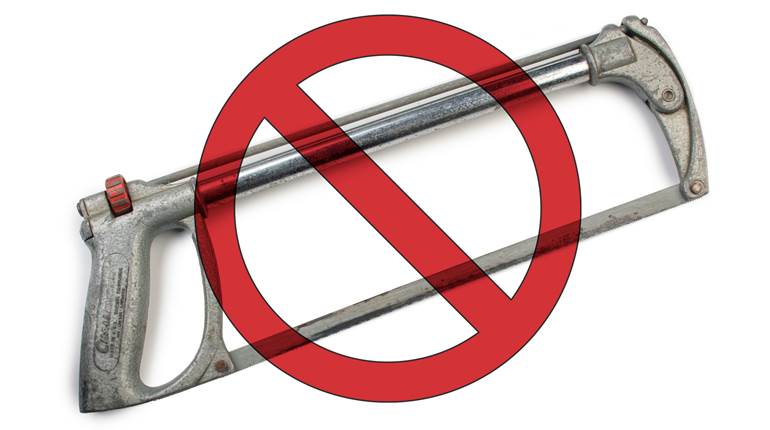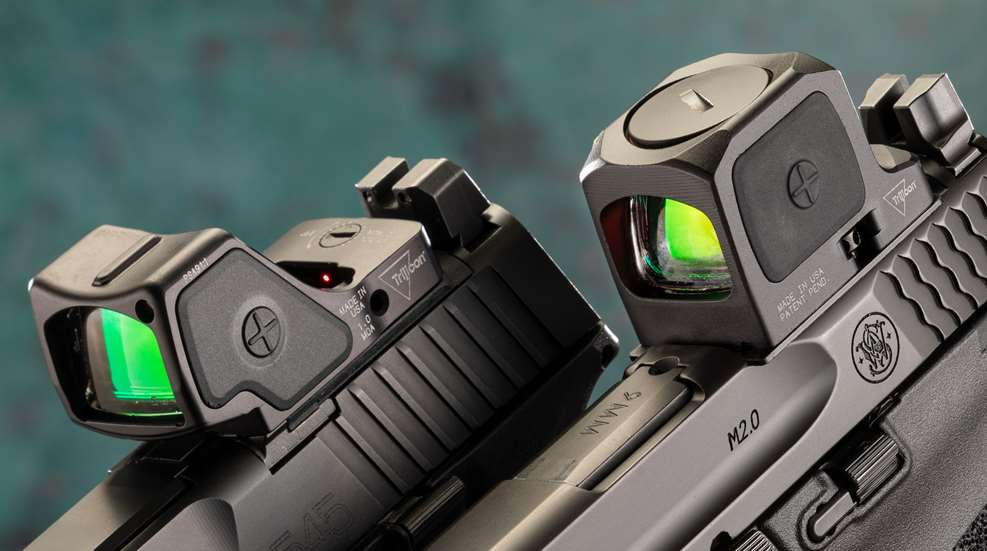
When first introduced in 2009, the Ruggedized Miniature Reflex (RMR) sight was initially designed for use aboard a fighting carbine as a 1X close-quarters complement to a rifle running Trijicon’s magnified ACOG as its primary optic and was thus overbuilt to help it withstand the host rifle potentially being dropped from height. And yet although the RMR was not at first envisioned for use mounted atop a handgun, the company’s micro red-dot (MRD) has nonetheless developed such a reputation for quality and dependability in this role since then that it is unquestionably one of the optics most responsible for the current pistol-mounted-red-dot craze.
The RMR has become so pervasive and influential, in fact, that I have found people mistakenly identifying all MRDs as “RMRs” to be a fairly commonplace occurrence. Today, the concept of machining a pistol’s slide so that an unmagnified reflex optic can be affixed atop it has reached such a level of popularity that new models without this capability are considered by many (myself among them) to be deficient.
New for 2023, Trijicon is bolstering its already solid MRD lineup with a pair of new models. The first is the RMR HD, a featured-packed evolution of the RMR Type 2 that blends the RMR’s battle-tested ruggedness with the advanced functionality and more generous field of view of Trijicon’s Specialized Reflex Optic (SRO). The second has been dubbed the Ruggedized Closed Reflex, or RCR, an on-trend addition of an enclosed-emitter optic to the family that makes use of a simple but ingenious mounting solution that solves the installation issues that plague most sealed MRDs. I was able to acquire an example of each of the new optics, and what follows is a brief run-down of their features, as well as an evaluation of how they fared during testing, first at a media event in Texas and then later on the NRA Pubs test range in Virginia. But first, let’s rile up some fudds.
The Red-Dot Advantage
In many regards, MRDs are superior to traditional iron sights—they are faster on target, easier to use, more accurate and, in a sense, simpler. Yes, there is still some resistance to MRDs in the most staunchly traditionalist corners of the gun community, but the rest of us have already woken up to just how much of a good idea the pistol-borne red-dot is—hence the craze. Optics are just aiming aids, so it’s ironic that the acceptance of red-dots atop handguns has lagged so far behind their use aboard rifles and even shotguns, given that handguns are, by far, the platform that is the most inherently difficult to aim and control—and thus can derive the most benefit from a dot. And, of course, it doesn’t even have to be an either/or proposition, as co-witnessing an MRD with a gun’s irons just requires the right equipment and some forethought.
The true magic of a good MRD is not that it can get you on target more quickly than irons alone or that it lets you place your shots more accurately, it’s that it allows you to accomplish both simultaneously—not just one at the expense of the other. In a defensive scenario, the lone focal plane of a dot allows you to keep your focus where it ought to be: the threat. With a properly zeroed MRD, target acquisition is distilled down to a simple point and click. No need to reconcile multiple sighting elements at varying distances from your eye, just look at your target, place the bright red cursor where you want the bullet to go and then focus on executing a trigger pull that doesn’t drag the dot off your target before the sear releases.
Because eye relief is a non-factor in both cases, we don’t typically think of either iron sights or red-dots in terms of eye box, but, if we did, the latter’s would be comparatively colossal. Irons are only useful for telling where the gun is pointed along a very thin vector behind the firearm where both elements are perfectly aligned. On the other hand, with an MRD, any orientation where your eye can see the dot in the lens—whether several inches above, below or to either side of the sights—is an orientation where you are ready to put an accurate shot on target.
Everyone is a rock star at five yards, but it’s at distance where the accuracy benefits of the red-dot become most apparent. Put a novice on the 25-yard line with irons, and the target will rarely be struck at all. Now give that same newbie a dot-equipped pistol at 25 yards, and he or she miraculously transforms into a Toepperwein. And with practice comes life-saving speed that far eclipses what would be possible with a commensurate amount of training with irons alone.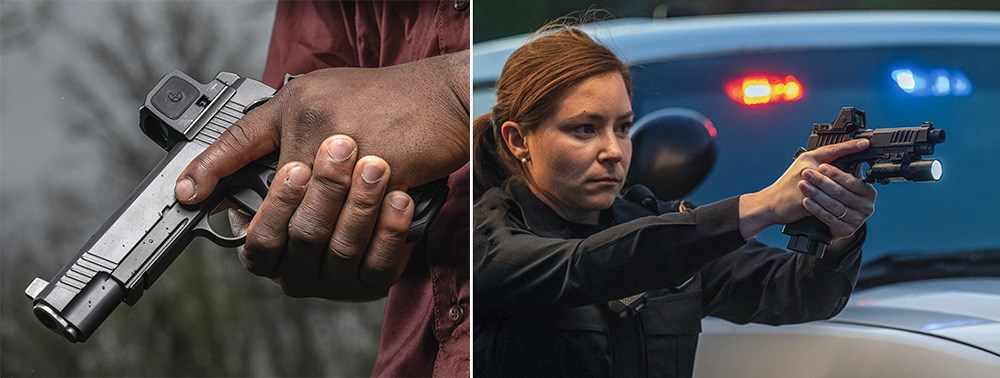
Shared Attributes
While different in many respects, Trijicon’s two newest optics nonetheless share a lot of common DNA, as each represents an adaptation of the Adjustable LED model of the RMR Type 2—with a few design updates that debuted first on the SRO in 2019 mixed in for good measure. Both are unmagnified (1X), LED-illuminated MRDs that, to steal a humorous line from a Dope Bag written about a red-dot many years ago, feature eye relief that is “limited only by the length of the shooter’s arm at one end or by the desire for optical intimacy at the other.”
After the RMRcc’s disappointing reception a few years back—the blame for which lies squarely on its proprietary footprint—both of these new models wisely employ the original RMR footprint for mounting to a pistol slide. For the enclosed RCR in particular, such simple compatibility with one of the most popular mounting footprints in the industry, without the need for additional plates, is a big deal. The HD and RCR also have identical deck heights to the Type 2, so not only can existing RMR owners directly swap out their old optic for one of the new ones, but all raised/suppressor-height irons compatible with the Type 2s will also work with the new models. The RMR HD can even use the same screws.
The epitome of “ruggedized,” both MRDs are assembled within a 7075-T6 aluminum housing, the same high-tensile-strength metal used in top-quality AR-15 receivers and aircraft. The RMR’s distinctive, concave top surface was developed to harmlessly shunt impact forces away from the optic’s internal circuitry, and the HD and RCR each take advantage of this design. A feature first appearing on the SRO, and a significant upgrade in my opinion, both new Trijicons employ a top-loading battery compartment that doesn’t require that the optic be unmounted from the pistol in order to replace its single CR2032 cell.
In decades past, the red-dot’s dependency on its battery could be viewed as a legitimate disadvantage, but MRD battery lives have improved so dramatically in recent years that this concern has essentially been rendered moot. The HD and RCR each have a battery life of at least three years (the less complex RCR can last up to six years) of continuous use at brightness setting No. 5—which is amazing. Both optics also include an auto-dimming feature that takes them down to their lowest illumination settings after 16.5 hours of inactivity to prolong battery life. Just change all your batteries out every two years on election night and consider it good.
Adjustable-LED RMRs and the SRO have previously been afflicted with somewhat mushy, indistinct brightness controls (the RCR has 10 brightness settings, the HD has nine manual settings and one automatic) and the buttons on both new models are far improved compared to their predecessors’. Depressing each control provides immediate feedback that can be both felt and heard.
Trijicon is likewise touting similar improvements made to the two new models’ elevation/windage adjustments, and while I will admit that the 1-m.o.a. clicks are more distinct if you are paying close enough attention, they are still quite subtle. Faint enough that attempts to “shoot the square” with the optics in an effort to gauge click consistency were largely futile—which would have been a nice thing to be able to confirm but isn’t of terrible importance on optics that are intended to be zeroed once and then their turrets never touched again.
Fortunately, zeroing an RMR-family MRD couldn’t be any simpler; turning the elevation screw in the up-indicated direction moves the impact up, and so forth. At 10 yards, it usually takes less than five shots. And lastly, both new Trijicons, which each bear an MSRP of $849, are being manufactured in the U.S. by an American workforce—which is, sadly, a pretty rare occurrence within the optics industry.
RMR HD
The HD looks like the merging of an RMR with an SRO—although at 2.13" long, 1.19" tall and 1.25" wide, and with a raised lens that extends forward of the unit’s deck—it is sized and shaped more like the target-shooting latter than the concealed-carry-friendly former. It acts that way, too; users of the SRO will feel right at home with the control scheme of the HD, as they are identical. While its 0.93"x0.67" viewing pane is actually no larger than the original RMR’s, it appears to the eye to be substantially more view-filling, as positioning the HD’s lens about 1/10" higher makes more of it usable to the shooter, since the bottom quarter of the RMR’s lens has always been hidden behind its housing.

As is standard of reflex-style sights, an LED emitter within the deck of the HD is projected onto the curved lens of the optic to produce its reticle. In company parlance, “HD” denotes that an optic employs a more complex reticle that includes a 55-m.o.a. segmented circle surrounding the center aiming dot. Two versions of the RMR HD are being offered at launch: one has a fine 1-m.o.a. aiming point and the other has a larger 3.25-m.o.a. dot. It was an example of the more versatile (in my opinion) 3.25-m.o.a. SKU that I received for testing; its dot subtends to 3.25" at 100 yards, which means it occludes only 0.23" of the target at 7 yards and 0.81" at 25 yards—pretty much ideal for both ranges.
In manual-brightness mode, there are a total of nine levels, three of which are compatible with night-vision devices and one that Trijicon calls “Super Bright.” On both variants, the relative brightness of the segmented circle to the center dot can be adjusted, or the circle can be disabled entirely. For distance work, a lone red dot is more than sufficient, but for close encounters, I prefer the presence of the larger circle. At ranges where speed is vital and precision is an ancillary perk, the larger reticle lets me know in the blink of an eye that my bullet is going to score a hit somewhere center mass—regardless of rushed, inexpert trigger work. Also greatly enhancing the HD’s usefulness at contact distances is an indexing ridge that Trijicon has added to the top surface of the housing; in extreme close-quarters engagements where taking the time to locate your dot isn’t an option, this centralized ridge allows point shooting to be done much more accurately.
New to the HD is a forward-facing light sensor that, when the optic is set in automatic-brightness mode, reads the lighting conditions at the target—instead of only at the shooter—and adjusts the brightness of the reticle accordingly. This means the user no longer needs to worry about his or her reticle either washing-out or blooming when engaging a well-illuminated target from a dimly lit location, or vice versa.
The HD is feature-dense—almost dauntingly so at first. It has a ton of user-configurable settings, all of which are accessed via a series of short and long presses to the unit’s relatively small number of buttons, which would make navigation of the optic ponderous if not for an included “buttonology” quick-reference guide. With the right combination of button presses, among other things, the MRD’s brightness settings can be toggled between automatic and manual control, its brightness can be locked at one setting or its factory default settings can be restored, and the HD will remember its settings even with the battery removed.
RCR
Aimpoint’s ACRO resonated with MRD users following its launch back in 2019, and the competition has been quick to capitalize with a profusion of similar enclosed-emitter models. By fully securing the LED within the unit’s housing, these designs eliminate the possibility of debris or moisture accumulating in the emitter window, making them especially appealing for use in desert and particularly rainy/snowy environments. The result is an optic that provides the benefits of a larger, tube-style red-dot in a package that is light enough for reliable use atop a reciprocating pistol slide.
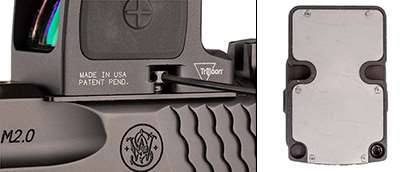
Looking more like a cross between an RMR and a CRT television set, the RCR’s boxy housing measures 1.78"x1.25"x1.17", basically the same length and width as the Type 2 RMR, but about 0.2" taller. The screen’s size and shape are essentially identical to that of the Type 2, but, again, by elevating it slightly, Trijicon has brought a noticeable bit more of it into view. With an installed battery (and screws) it weighs just 1.95 ozs.—making the RCR one of the lightest enclosed MRDs on the market. Only one version is offered at launch; it employs a simple 3.25-m.o.a. dot as its reticle.
But the RCR’s patented mounting system is the real story here. A conventional MRD with an exposed emitter is affixed to its host by a pair of screws that thread through holes in the optic to adhere it to the pistol’s slide—but the enclosed housings of models like the ACRO preclude such simple mounting, forcing these designs to rely on intermediate, optic-specific plates. Trijicon’s engineers have devised an uncomplicated but highly effective installation method that instead employs a pair of capstan screws to hold the RCR in place atop a standard RMR-footprint mount. Using a provided hex key, which is inserted into the side of the capstan screws’ heads rather than their faces, the screws are slowly tightened via slots in the sides of the RCR. The installation process takes a bit longer than with conventional screws, as each capstan screw can only be tightened about a quarter of a turn at a time, but I found it to be quite foolproof and secure.
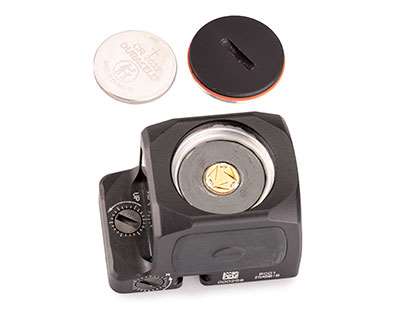
Whereas the HD has a ton going on feature-wise, arguably more than some users will need, the RCR is streamlined to provide shooters with just the functionality required for carry. Brightness settings (three of which are night-vision compatible) are manually controlled, so no light sensor is required, although the user can lock in his or her preferred setting and disable the adjustment buttons. Befitting its sealed construction, the RCR has been purged of air and filled with inert argon gas to prevent fogging from temperature changes, and the optic is waterproof down to 65 feet.
Put To Work
In addition to battery life, the other critique often leveled at MRDs is durability, a quality that I admit can be lacking in some lower-tier offerings—but that Trijicons have always had in spades. During a March event under the tutelage of Scott Jedlinski of Modern Samurai Project, we subjected both optics to a level of abuse that far exceeded simple negligence and crossed into the territory of direct malice.

After two days of intense training with optic-topped Glock 19s, during which seven attendees expended close to 6,000 rounds of ammunition, a sawhorse was brought out to illustrate just how hardy the new optics are. Each of us first took turns forcefully racking the slides of the empty guns with one hand several times, using the MRD to do so, as one would a rear sight’s tactical ledge. We then proceeded to use each pistol as if it were a hammer driving a nail, bashing the red-dots repeatedly directly into the sawhorse—an exercise that did more apparent damage to the sawhorse than to the optics. I mean, we really got after it.
How did the RMR HDs and RCRs respond? All 14 optics not only remained completely operational, they also perfectly retained their zeros. Some were thrown repeatedly into the air, some RCRs were kicked around in the dirt—all remained unfazed. Once I got the Trijicons home, I installed the HD aboard an FN 545 Tactical and the RCR atop an S&W M&P9 Compact OR and ran an additional 180 and 300 rounds through them, respectively, with no change in function or zero. Thankfully, few guns in the wild will ever experience a fraction of this abuse, but after witnessing what the new Trijicons can shrug off, consider my confidence thoroughly instilled.
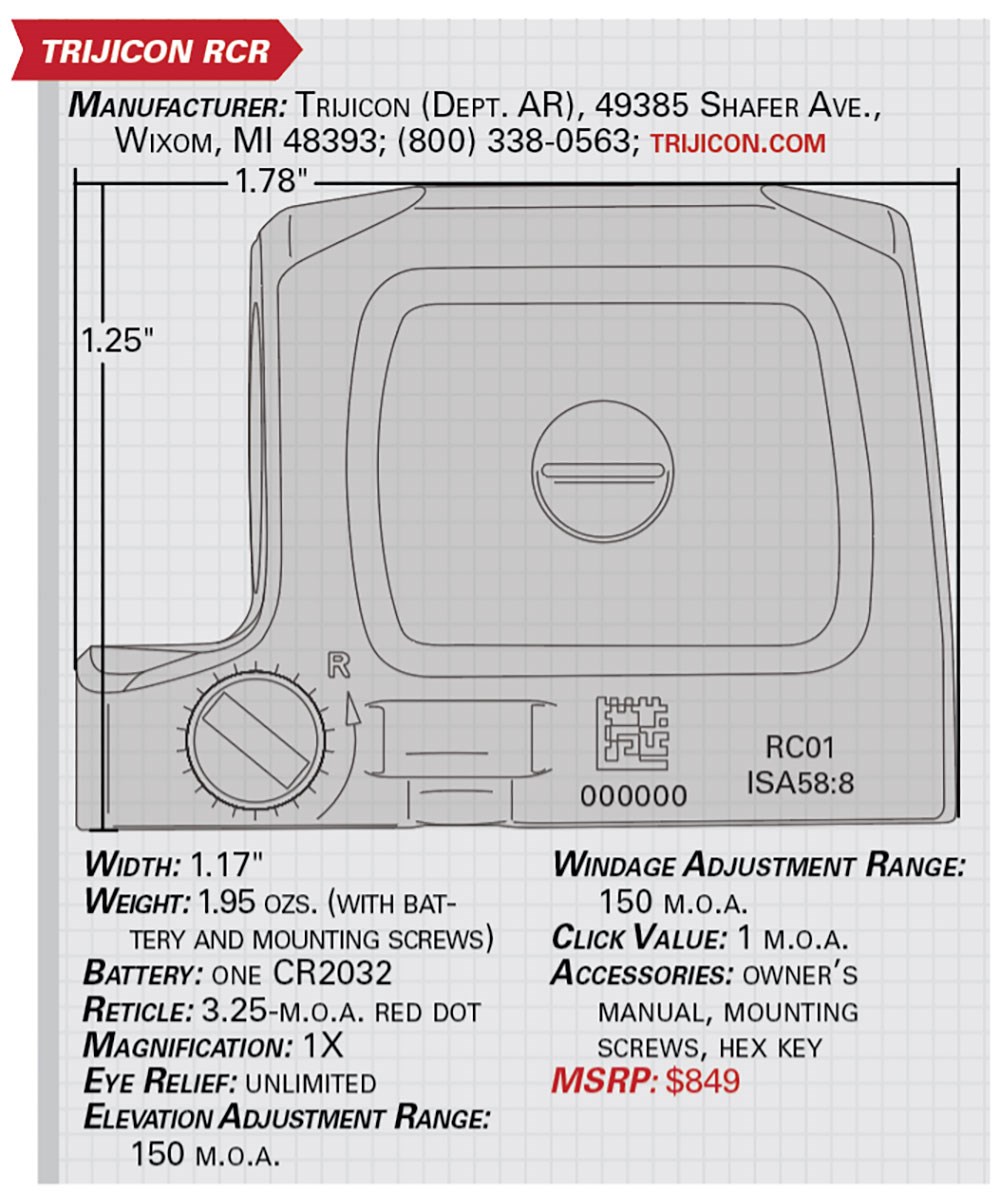
Trijicon takes feedback received from its end users very seriously—as they are frequently military and law-enforcement personnel who may need to depend upon their firearms/optics with their lives—and both of the new 2023 models are the result of customer requests. Each is a well-wrought addition to the Trijicon line that will only improve the RMR’s legacy and reputation. Both represent an improvement compared to the Type 2, they just go about it in different ways and will likely find themselves primarily being put to use in different applications.
The larger size, generous viewing pane and automatic brightness controls of the HD best lend the optic to use atop full-size pistols for duty carry or home defense—and while nothing beats the SRO for square-range work, the HD comes close. The RCR, on the other hand, is even more multi-purpose, as it could certainly serve competently in any of the above uses but is compact enough for concealed carry, as well. And, while they represent the next generation of Trijicon MRDs, the new models are not replacing the Type 2 in the company catalog, so fans of the original will continue to have that option.
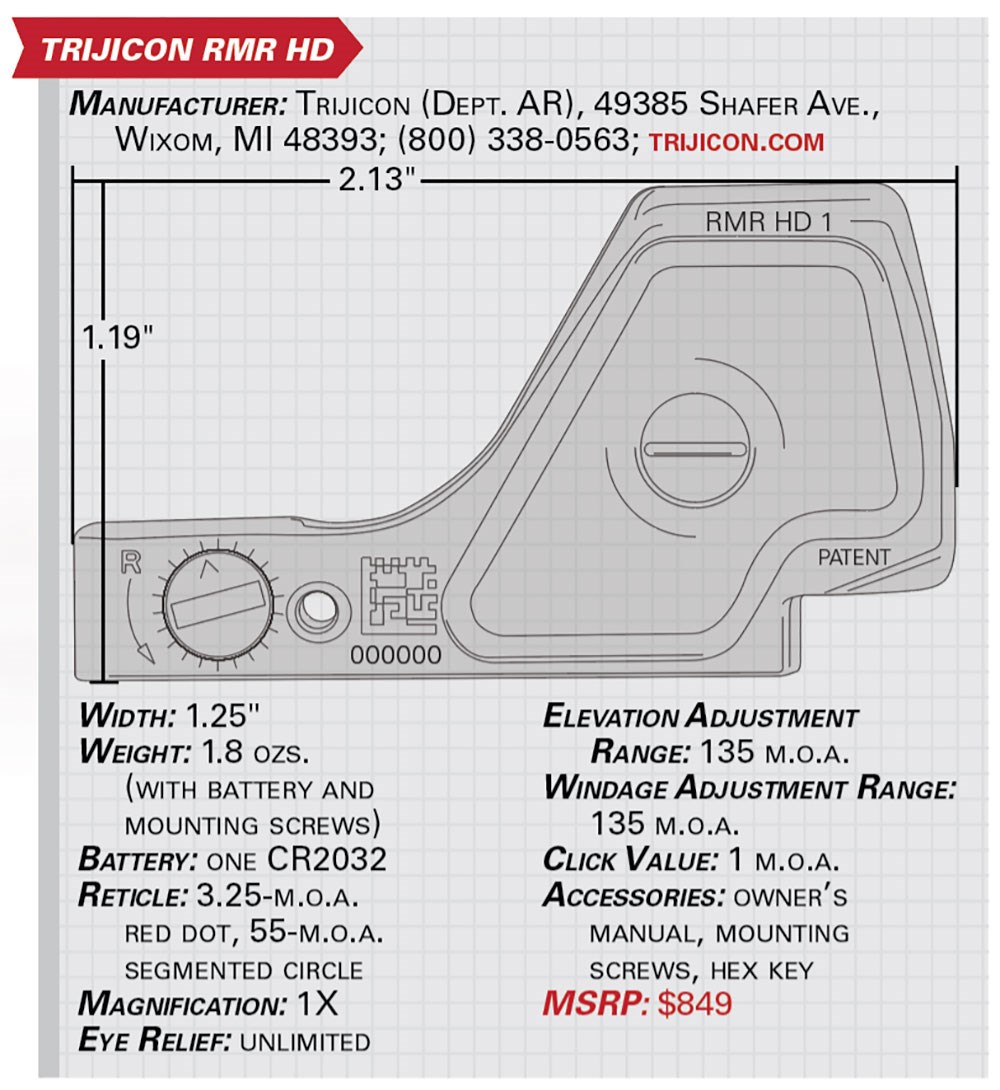
I have long said that silencers provide such an improved experience that they ruin unsuppressed fire for shooters, and I view MRDs in much the same vein for pistols—once you’ve experienced the benefits, reverting back to only irons feels substandard. And in a life-or-death confrontation, why would I choose to deny myself any advantage possible? A wise man once told me, “In a gunfight, if you’re not cheating, you’re not trying hard enough to stay alive.” Well, an MRD certainly makes it feel like you’re cheating—and the new RMR HD and RCR are among the very highest-quality pistol optics I’ve ever encountered.













